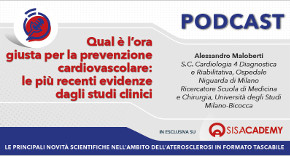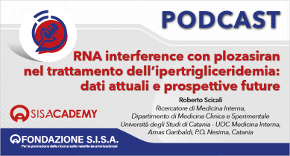 Rivista in lingua italiana
Rivista in lingua italiana
riservata ai Soci SISA
Ultimo numero:
Anno 16 • N.1/2025
Abstract
Clinical predictors of plaque progression despite very low levels of low-density
Bayturan O, Kapadia S, Nicholls SJ, Tuzcu EM, Shao M, Uno K, Shreevatsa A, Lavoie AJ, Wolski K, Schoenhagen P, Nissen SE.
J Am Coll Cardiol 2010;55:2736-42
OBJECTIVES: The purpose of this study was to characterize the determinants of plaque progression despite achieving very low levels of low-density lipoprotein cholesterol (LDL-C).
BACKGROUND: Despite achieving very low levels of LDL-C, many patients continue to demonstrate disease progression and have clinical events.
METHODS: A total of 3,437 patients with coronary artery disease underwent serial intravascular ultrasound examination in 7 clinical trials. Patients who achieved an on-treatment LDL-C level of <or=70 mg/dl (n = 951) were stratified as progressors (n = 200) and nonprogressors (n = 751) and compared.
RESULTS: Despite achieving LDL-C <or=70 mg/dl, >20% of patients continued to progress. There were no demographic differences between groups. Progressors demonstrated higher baseline levels of glucose (117.1 +/- 42.5 mg/dl vs. 112.1 +/- 40.0 mg/dl, p = 0.02), triglycerides (157.5 mg/dl vs. 133.0 mg/dl, p = 0.004), and a smaller decrease of apolipoprotein B (-25.1 +/- 3.4 mg/dl vs. -27.4 +/- 3.35 mg/dl, p = 0.01) at follow-up. Multivariable analysis revealed that independently associated risk factors of progression in patients with LDL-C <or=70 mg/dl included baseline percent atheroma volume (p = 0.001), presence of diabetes mellitus (p = 0.02), increase in systolic blood pressure (p = 0.001), less increase in high-density lipoprotein cholesterol (p = 0.01), and a smaller decrease in apolipoprotein B levels (p = 0.001), but not changes in C-reactive protein (p = 0.78) or LDL-C (p = 0.84).
CONCLUSIONS: Residual risk factors are associated with the likelihood of disease progression in patients who achieve very low LDL-C levels. In addition, the association between apolipoprotein B and atheroma progression highlights the potential importance of LDL particle concentration in patients with optimal LDL-C control. This finding highlights the need for intensive modification of global risk in patients with coronary artery disease.
J Am Coll Cardiol 2010;55:2736-42

Area Soci
Eventi
39° Congresso Nazionale
 39° Congresso Nazionale
39° Congresso NazionaleRoma, 23-25 novembre 2025
Save the date




 Spring Meeting Gruppi Giovani SID, SIGG, SIIA, SIMI, SIPREC, SISA
Spring Meeting Gruppi Giovani SID, SIGG, SIIA, SIMI, SIPREC, SISARimini, 6-8 aprile 2025
[continua a leggere]
 SISA LIPID ACADEMY - Corso avanzato di lipidologia clinica
SISA LIPID ACADEMY - Corso avanzato di lipidologia clinicaModena, 4-5 Luglio 2024
[continua a leggere]Giornale Italiano Arteriosclerosi
HoFH today
 Rivista Italiana della
Rivista Italiana della
Ipercolesterolemia
Familiare Omozigote
Anno 6 • N.1/2024
Rivista NMCD
Diateca
[continua a leggere]
[continua a leggere]
Newsletter
il vostro indirizzo di posta elettronica
Progetto LIPIGEN

Nuovo sito dedicato al Progetto LIPIGEN
Progetto LIPIGEN - Vecchio portale
E' necessario essere loggati come utente
Lipigen per poter accedere alla pagina
PROject Statin Intolerance SISA
PROSISA – PROject Statin Intolerance SISA
E' necessario essere loggati come utente
PROSISA per poter accedere alla pagina
GILA - Lipoprotein Aferesi
Gruppo Interdisciplinare Lipoprotein Aferesi
(Accesso Gruppo GILA-Lipoprotein Aferesi)
E' necessario essere loggati come utente del Gruppo GILA per poter accedere
Gruppo Interdisciplinare Lipoprotein Aferesi
(Documentazione ad accesso libero)
Pagina informativa per medici e pazienti










